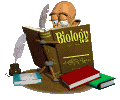
Microorganisms

Chapter Objectives
At the end of this unit students
will be able to
1. describe why a virus is not considered a living organism.
2. describe the basic structure of a virus.
3. describe lytic and lysogenic viral replication cycles.
4. list the basic structure and characteristics of Archaebacteria and
Eubacteria.
5. list the distinguishing features of the main protistan phyla.
6. describe sexual an asexual reproduction methods in unicellular and
multicellular protistans.
7. list the characteristics and transmission of several protistan diseases.
8. list the characteristics and transmission of several viral diseases.
9. list the characteristics and transmission of several bacterial diseases.
10. list seven differences between bacteria and eukaryotic cells.
Chapter Terms
| Viruses and Bacteria | Protista |
| virus pathogen capsid envelope glycoprotein bacteriophage lytic provirus lysogenic prion viroid bacillus coccus spirillum capsule antibiotic endospore conjugation anaerobic aerobic toxin |
Protozoan Alga Zygospore Alternation of generations Sporangium Amoeba Pseudopodium Diatom Euglenoid Plasmodium |
| Fungi | |
| Chitin Hypha Mycelium Yeast Budding lichen |
Animated
Graphics Courtesy of

Jo's World